engine JEEP RENEGADE 2014 1.G Manual PDF
[x] Cancel search | Manufacturer: JEEP, Model Year: 2014, Model line: RENEGADE, Model: JEEP RENEGADE 2014 1.GPages: 212, PDF Size: 17.48 MB
Page 167 of 212
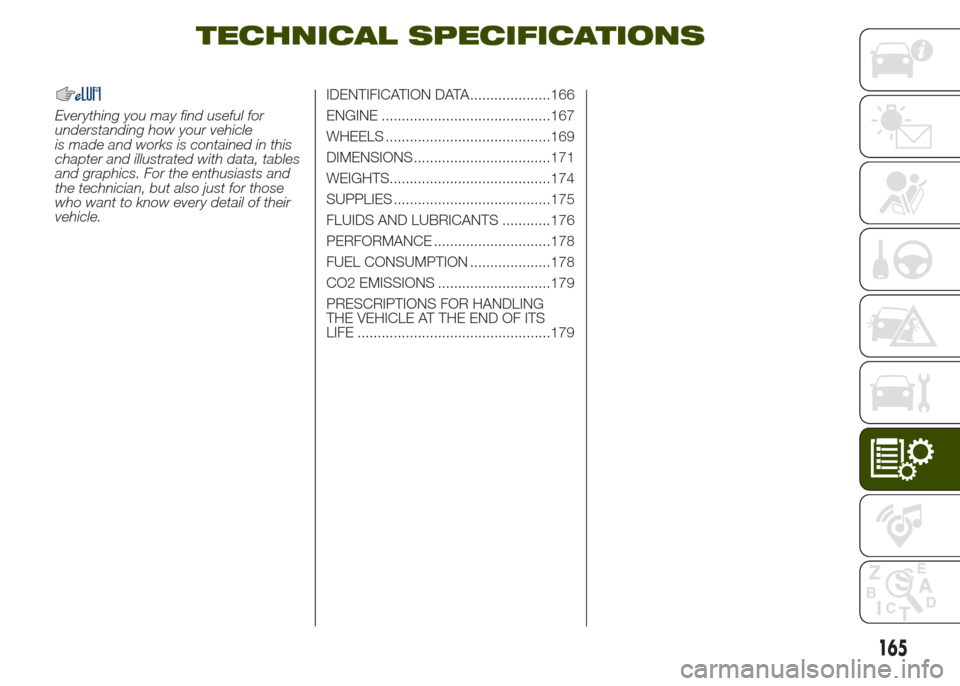
TECHNICAL SPECIFICATIONS
Everything you may find useful for
understanding how your vehicle
is made and works is contained in this
chapter and illustrated with data, tables
and graphics. For the enthusiasts and
the technician, but also just for those
who want to know every detail of their
vehicle.IDENTIFICATION DATA....................166
ENGINE ..........................................167
WHEELS .........................................169
DIMENSIONS ..................................171
WEIGHTS........................................174
SUPPLIES .......................................175
FLUIDS AND LUBRICANTS ............176
PERFORMANCE .............................178
FUEL CONSUMPTION ....................178
CO2 EMISSIONS ............................179
PRESCRIPTIONS FOR HANDLING
THE VEHICLE AT THE END OF ITS
LIFE ................................................179
165
Page 168 of 212
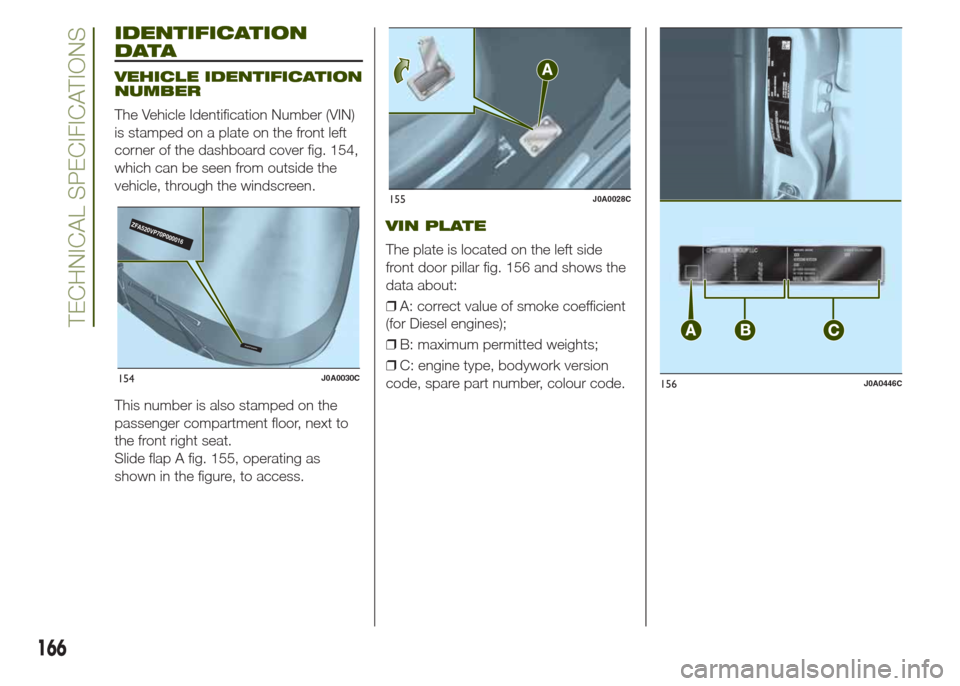
IDENTIFICATION
DATA
VEHICLE IDENTIFICATION
NUMBER
The Vehicle Identification Number (VIN)
is stamped on a plate on the front left
corner of the dashboard cover fig. 154,
which can be seen from outside the
vehicle, through the windscreen.
This number is also stamped on the
passenger compartment floor, next to
the front right seat.
Slide flap A fig. 155, operating as
shown in the figure, to access.
VIN PLATE
The plate is located on the left side
front door pillar fig. 156 and shows the
data about:
❒A: correct value of smoke coefficient
(for Diesel engines);
❒B: maximum permitted weights;
❒C: engine type, bodywork version
code, spare part number, colour code.
Z
FA520VP70P000016
ZFA520VP70P000016
154J0A0030C
155J0A0028C
156J0A0446C
166
TECHNICAL SPECIFICATIONS
Page 169 of 212
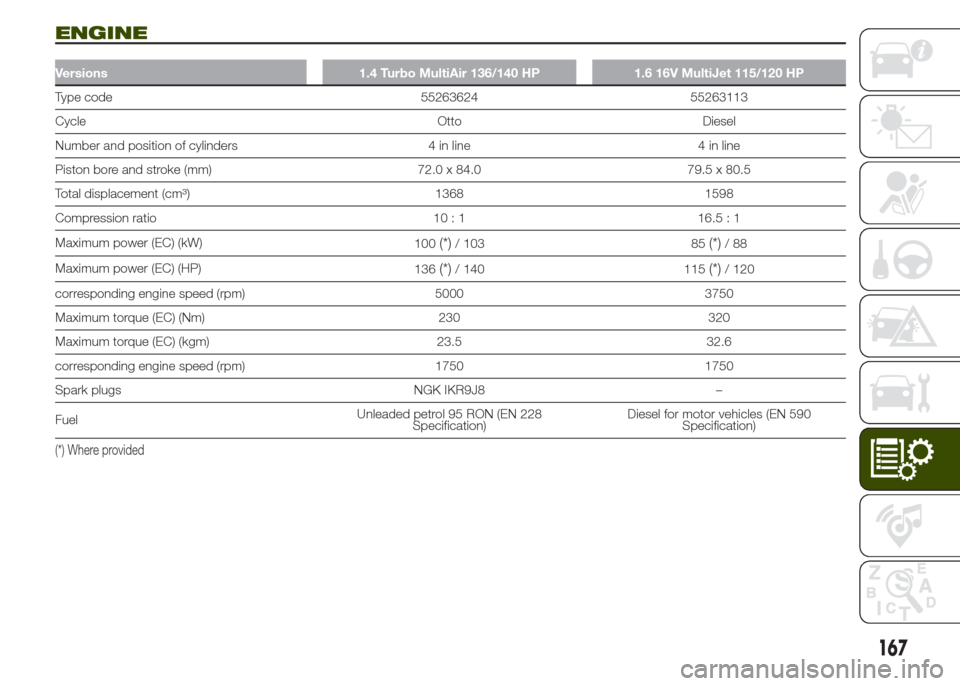
ENGINE
Versions 1.4 Turbo MultiAir 136/140 HP 1.6 16V MultiJet 115/120 HP
Type code 55263624 55263113
Cycle Otto Diesel
Number and position of cylinders 4 in line 4 in line
Piston bore and stroke (mm) 72.0 x 84.0 79.5 x 80.5
Total displacement (cm³) 1368 1598
Compression ratio 10 : 1 16.5 : 1
Maximum power (EC) (kW)
100
(*)/ 103 85(*)/88
Maximum power (EC) (HP)
136
(*)/ 140 115(*)/ 120
corresponding engine speed (rpm) 5000 3750
Maximum torque (EC) (Nm) 230 320
Maximum torque (EC) (kgm) 23.5 32.6
corresponding engine speed (rpm) 1750 1750
Spark plugs NGK IKR9J8 –
FuelUnleaded petrol 95 RON (EN 228
Specification)Diesel for motor vehicles (EN 590
Specification)
(*) Where provided
167
Page 170 of 212
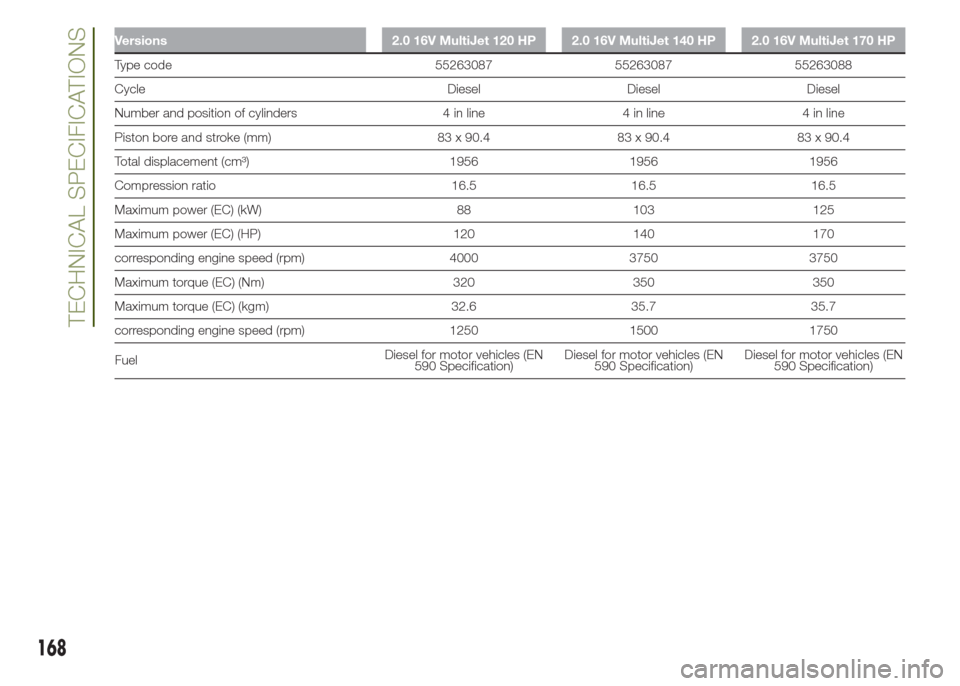
Versions 2.0 16V MultiJet 120 HP 2.0 16V MultiJet 140 HP 2.0 16V MultiJet 170 HP
Type code 55263087 55263087 55263088
Cycle Diesel Diesel Diesel
Number and position of cylinders 4 in line 4 in line 4 in line
Piston bore and stroke (mm) 83 x 90.4 83 x 90.4 83 x 90.4
Total displacement (cm³) 1956 1956 1956
Compression ratio 16.5 16.5 16.5
Maximum power (EC) (kW) 88 103 125
Maximum power (EC) (HP) 120 140 170
corresponding engine speed (rpm) 4000 3750 3750
Maximum torque (EC) (Nm) 320 350 350
Maximum torque (EC) (kgm) 32.6 35.7 35.7
corresponding engine speed (rpm) 1250 1500 1750
FuelDiesel for motor vehicles (EN
590 Specification)Diesel for motor vehicles (EN
590 Specification)Diesel for motor vehicles (EN
590 Specification)
168
TECHNICAL SPECIFICATIONS
Page 177 of 212
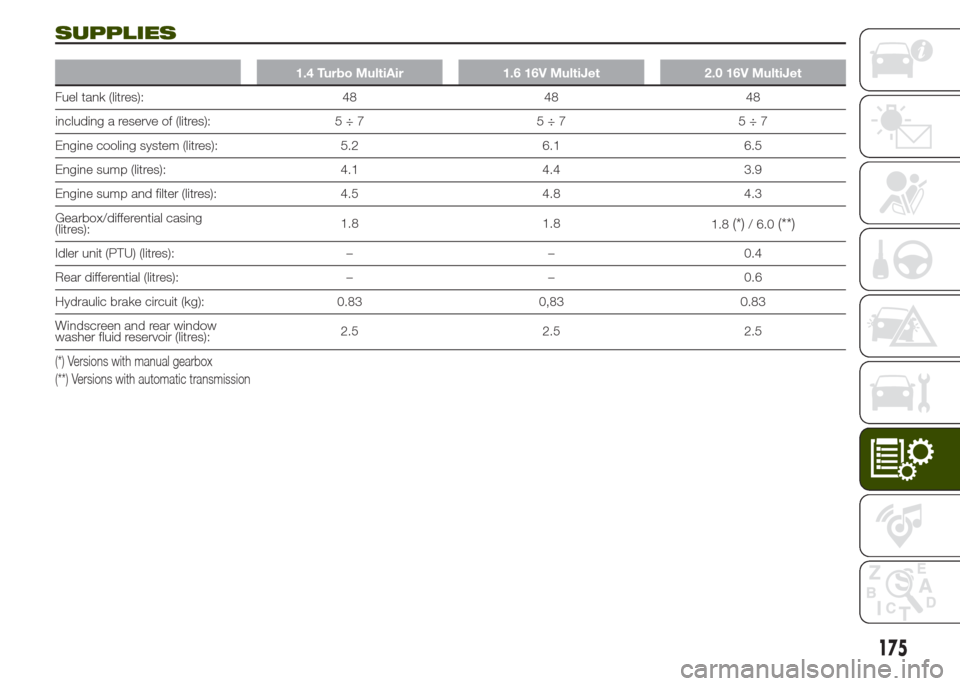
SUPPLIES
1.4 Turbo MultiAir 1.6 16V MultiJet 2.0 16V MultiJet
Fuel tank (litres): 48 48 48
including a reserve of (litres): 5 ÷ 7 5 ÷ 7 5 ÷ 7
Engine cooling system (litres): 5.2 6.1 6.5
Engine sump (litres): 4.1 4.4 3.9
Engine sump and filter (litres): 4.5 4.8 4.3
Gearbox/differential casing
(litres):1.8 1.8
1.8
(*)/ 6.0(**)
Idler unit (PTU) (litres): – – 0.4
Rear differential (litres): – – 0.6
Hydraulic brake circuit (kg): 0.83 0,83 0.83
Windscreen and rear window
washer fluid reservoir (litres):2.5 2.5 2.5
(*) Versions with manual gearbox
(**) Versions with automatic transmission
175
Page 178 of 212
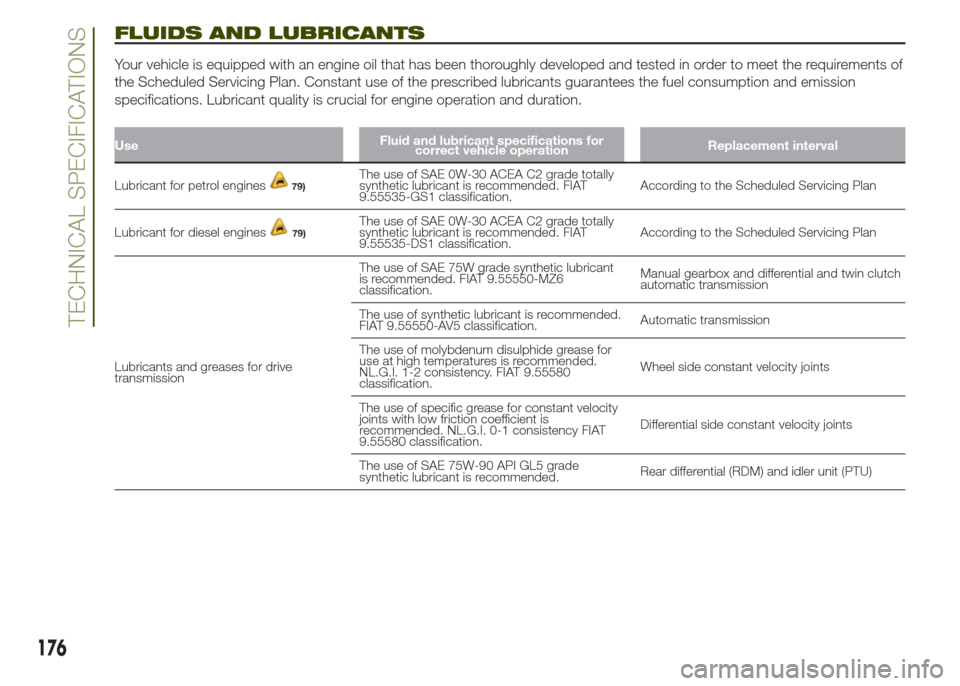
FLUIDS AND LUBRICANTS
Your vehicle is equipped with an engine oil that has been thoroughly developed and tested in order to meet the requirements of
the Scheduled Servicing Plan. Constant use of the prescribed lubricants guarantees the fuel consumption and emission
specifications. Lubricant quality is crucial for engine operation and duration.
UseFluid and lubricant specifications for
correct vehicle operationReplacement interval
Lubricant for petrol engines79)The use of SAE 0W-30 ACEA C2 grade totally
synthetic lubricant is recommended. FIAT
9.55535-GS1 classification.According to the Scheduled Servicing Plan
Lubricant for diesel engines
79)The use of SAE 0W-30 ACEA C2 grade totally
synthetic lubricant is recommended. FIAT
9.55535-DS1 classification.According to the Scheduled Servicing Plan
Lubricants and greases for drive
transmissionThe use of SAE 75W grade synthetic lubricant
is recommended. FIAT 9.55550-MZ6
classification.Manual gearbox and differential and twin clutch
automatic transmission
The use of synthetic lubricant is recommended.
FIAT 9.55550-AV5 classification.Automatic transmission
The use of molybdenum disulphide grease for
use at high temperatures is recommended.
NL.G.I. 1-2 consistency. FIAT 9.55580
classification.Wheel side constant velocity joints
The use of specific grease for constant velocity
joints with low friction coefficient is
recommended. NL.G.I. 0-1 consistency FIAT
9.55580 classification.Differential side constant velocity joints
The use of SAE 75W-90 API GL5 grade
synthetic lubricant is recommended.Rear differential (RDM) and idler unit (PTU)
176
TECHNICAL SPECIFICATIONS
Page 179 of 212
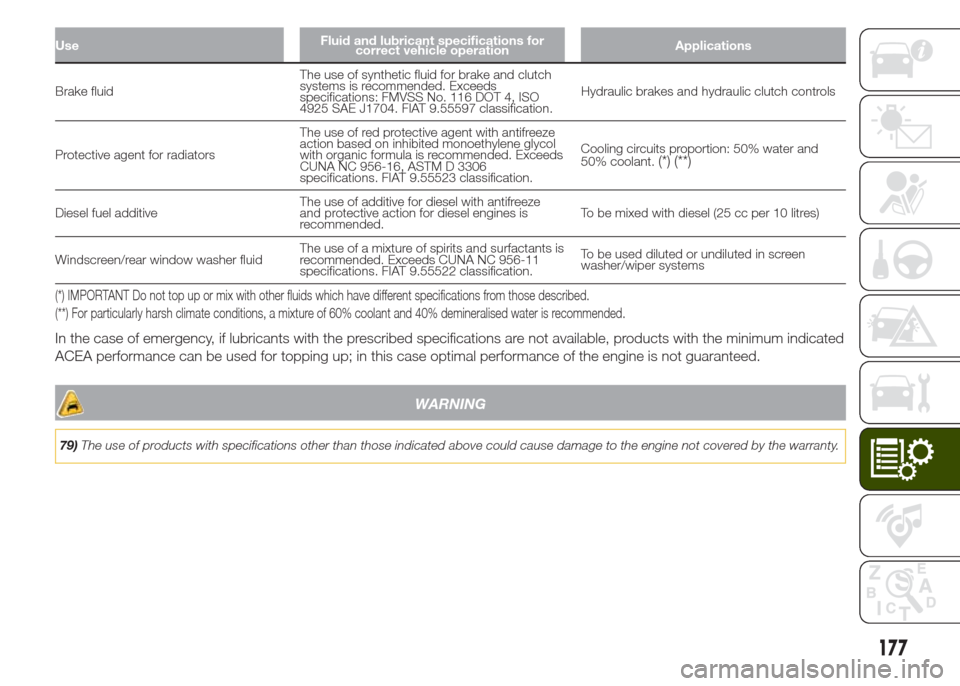
UseFluid and lubricant specifications for
correct vehicle operationApplications
Brake fluidThe use of synthetic fluid for brake and clutch
systems is recommended. Exceeds
specifications: FMVSS No. 116 DOT 4, ISO
4925 SAE J1704. FIAT 9.55597 classification.Hydraulic brakes and hydraulic clutch controls
Protective agent for radiatorsThe use of red protective agent with antifreeze
action based on inhibited monoethylene glycol
with organic formula is recommended. Exceeds
CUNA NC 956-16, ASTM D 3306
specifications. FIAT 9.55523 classification.Cooling circuits proportion: 50% water and
50% coolant.
(*) (**)
Diesel fuel additiveThe use of additive for diesel with antifreeze
and protective action for diesel engines is
recommended.To be mixed with diesel (25 cc per 10 litres)
Windscreen/rear window washer fluidThe use of a mixture of spirits and surfactants is
recommended. Exceeds CUNA NC 956-11
specifications. FIAT 9.55522 classification.To be used diluted or undiluted in screen
washer/wiper systems
(*) IMPORTANT Do not top up or mix with other fluids which have different specifications from those described.
(**) For particularly harsh climate conditions, a mixture of 60% coolant and 40% demineralised water is recommended.
In the case of emergency, if lubricants with the prescribed specifications are not available, products with the minimum indicated
ACEA performance can be used for topping up; in this case optimal performance of the engine is not guaranteed.
WARNING
79)The use of products with specifications other than those indicated above could cause damage to the engine not covered by the warranty.
177
Page 181 of 212
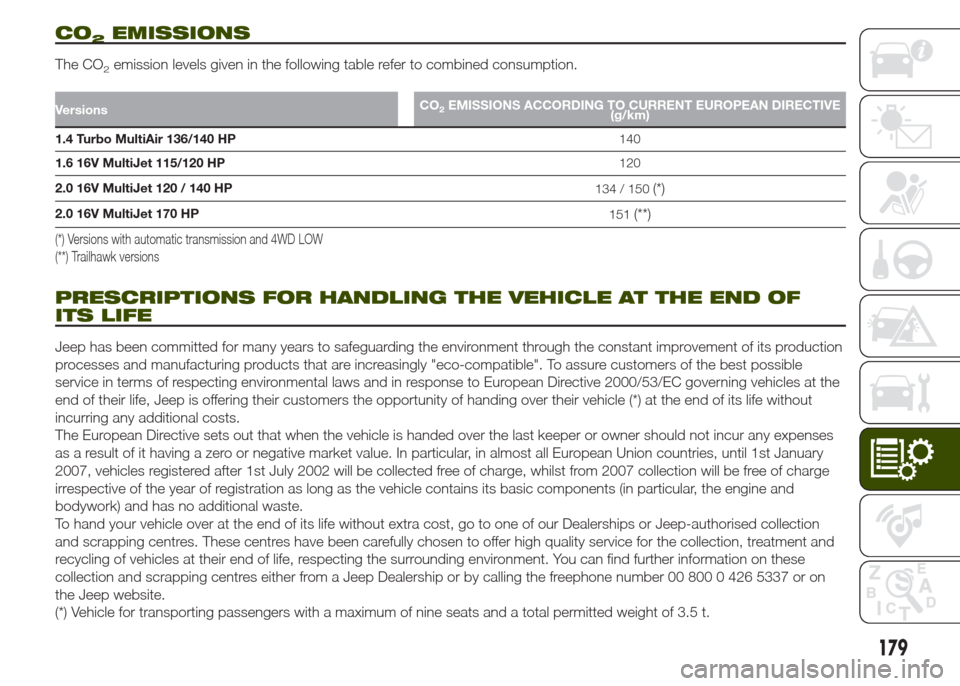
CO2EMISSIONS
The CO2emission levels given in the following table refer to combined consumption.
VersionsCO2EMISSIONS ACCORDING TO CURRENT EUROPEAN DIRECTIVE
(g/km)
1.4 Turbo MultiAir 136/140 HP140
1.6 16V MultiJet 115/120 HP120
2.0 16V MultiJet 120 / 140 HP
134 / 150
(*)
2.0 16V MultiJet 170 HP
151(**)
(*) Versions with automatic transmission and 4WD LOW
(**) Trailhawk versions
PRESCRIPTIONS FOR HANDLING THE VEHICLE AT THE END OF
ITS LIFE
Jeep has been committed for many years to safeguarding the environment through the constant improvement of its production
processes and manufacturing products that are increasingly "eco-compatible". To assure customers of the best possible
service in terms of respecting environmental laws and in response to European Directive 2000/53/EC governing vehicles at the
end of their life, Jeep is offering their customers the opportunity of handing over their vehicle (*) at the end of its life without
incurring any additional costs.
The European Directive sets out that when the vehicle is handed over the last keeper or owner should not incur any expenses
as a result of it having a zero or negative market value. In particular, in almost all European Union countries, until 1st January
2007, vehicles registered after 1st July 2002 will be collected free of charge, whilst from 2007 collection will be free of charge
irrespective of the year of registration as long as the vehicle contains its basic components (in particular, the engine and
bodywork) and has no additional waste.
To hand your vehicle over at the end of its life without extra cost, go to one of our Dealerships or Jeep-authorised collection
and scrapping centres. These centres have been carefully chosen to offer high quality service for the collection, treatment and
recycling of vehicles at their end of life, respecting the surrounding environment. You can find further information on these
collection and scrapping centres either from a Jeep Dealership or by calling the freephone number 00 800 0 426 5337 or on
the Jeep website.
(*) Vehicle for transporting passengers with a maximum of nine seats and a total permitted weight of 3.5 t.
179
Page 191 of 212
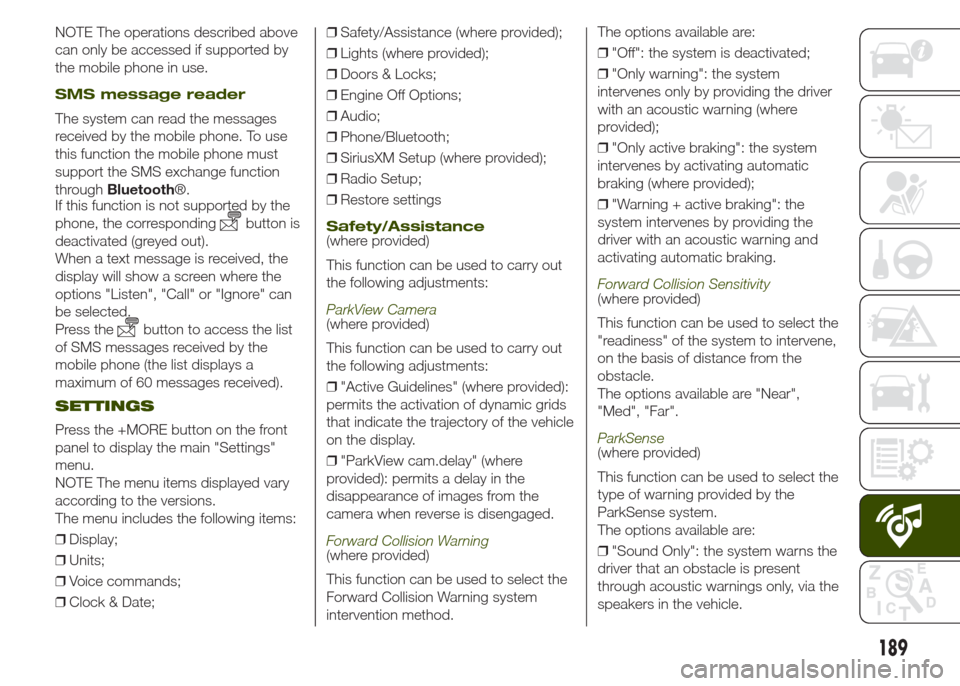
NOTE The operations described above
can only be accessed if supported by
the mobile phone in use.
SMS message reader
The system can read the messages
received by the mobile phone. To use
this function the mobile phone must
support the SMS exchange function
throughBluetooth®.
If this function is not supported by the
phone, the corresponding
button is
deactivated (greyed out).
When a text message is received, the
display will show a screen where the
options "Listen", "Call" or "Ignore" can
be selected.
Press the
button to access the list
of SMS messages received by the
mobile phone (the list displays a
maximum of 60 messages received).
SETTINGS
Press the +MORE button on the front
panel to display the main "Settings"
menu.
NOTE The menu items displayed vary
according to the versions.
The menu includes the following items:
❒Display;
❒Units;
❒Voice commands;
❒Clock & Date;❒Safety/Assistance (where provided);
❒Lights (where provided);
❒Doors & Locks;
❒Engine Off Options;
❒Audio;
❒Phone/Bluetooth;
❒SiriusXM Setup (where provided);
❒Radio Setup;
❒Restore settings
Safety/Assistance(where provided)
This function can be used to carry out
the following adjustments:
ParkView Camera(where provided)
This function can be used to carry out
the following adjustments:
❒"Active Guidelines" (where provided):
permits the activation of dynamic grids
that indicate the trajectory of the vehicle
on the display.
❒"ParkView cam.delay" (where
provided): permits a delay in the
disappearance of images from the
camera when reverse is disengaged.
Forward Collision Warning(where provided)
This function can be used to select the
Forward Collision Warning system
intervention method.The options available are:
❒"Off": the system is deactivated;
❒"Only warning": the system
intervenes only by providing the driver
with an acoustic warning (where
provided);
❒"Only active braking": the system
intervenes by activating automatic
braking (where provided);
❒"Warning + active braking": the
system intervenes by providing the
driver with an acoustic warning and
activating automatic braking.
Forward Collision Sensitivity(where provided)
This function can be used to select the
"readiness" of the system to intervene,
on the basis of distance from the
obstacle.
The options available are "Near",
"Med", "Far".
ParkSense(where provided)
This function can be used to select the
type of warning provided by the
ParkSense system.
The options available are:
❒"Sound Only": the system warns the
driver that an obstacle is present
through acoustic warnings only, via the
speakers in the vehicle.
189
Page 194 of 212
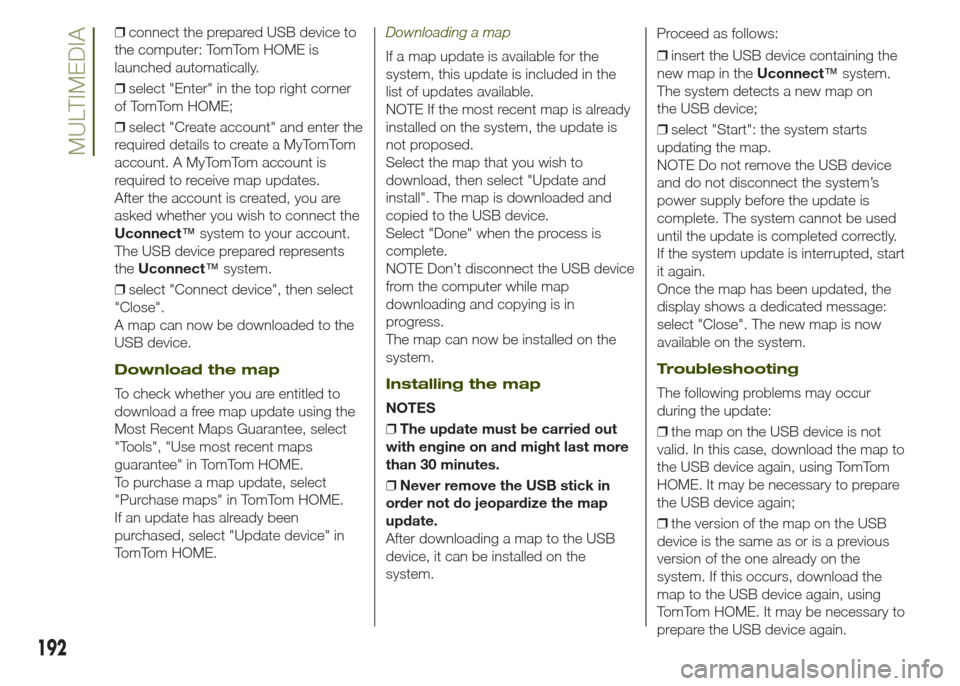
❒connect the prepared USB device to
the computer: TomTom HOME is
launched automatically.
❒select "Enter" in the top right corner
of TomTom HOME;
❒select "Create account" and enter the
required details to create a MyTomTom
account. A MyTomTom account is
required to receive map updates.
After the account is created, you are
asked whether you wish to connect the
Uconnect™system to your account.
The USB device prepared represents
theUconnect™system.
❒select "Connect device", then select
"Close".
A map can now be downloaded to the
USB device.
Download the map
To check whether you are entitled to
download a free map update using the
Most Recent Maps Guarantee, select
"Tools", "Use most recent maps
guarantee" in TomTom HOME.
To purchase a map update, select
"Purchase maps" in TomTom HOME.
If an update has already been
purchased, select "Update device" in
TomTom HOME.
Downloading a map
If a map update is available for the
system, this update is included in the
list of updates available.
NOTE If the most recent map is already
installed on the system, the update is
not proposed.
Select the map that you wish to
download, then select "Update and
install". The map is downloaded and
copied to the USB device.
Select "Done" when the process is
complete.
NOTE Don’t disconnect the USB device
from the computer while map
downloading and copying is in
progress.
The map can now be installed on the
system.
Installing the map
NOTES
❒The update must be carried out
with engine on and might last more
than 30 minutes.
❒Never remove the USB stick in
order not do jeopardize the map
update.
After downloading a map to the USB
device, it can be installed on the
system.Proceed as follows:
❒insert the USB device containing the
new map in theUconnect™system.
The system detects a new map on
the USB device;
❒select "Start": the system starts
updating the map.
NOTE Do not remove the USB device
and do not disconnect the system’s
power supply before the update is
complete. The system cannot be used
until the update is completed correctly.
If the system update is interrupted, start
it again.
Once the map has been updated, the
display shows a dedicated message:
select "Close". The new map is now
available on the system.
Troubleshooting
The following problems may occur
during the update:
❒the map on the USB device is not
valid. In this case, download the map to
the USB device again, using TomTom
HOME. It may be necessary to prepare
the USB device again;
❒the version of the map on the USB
device is the same as or is a previous
version of the one already on the
system. If this occurs, download the
map to the USB device again, using
TomTom HOME. It may be necessary to
prepare the USB device again.
192
MULTIMEDIA